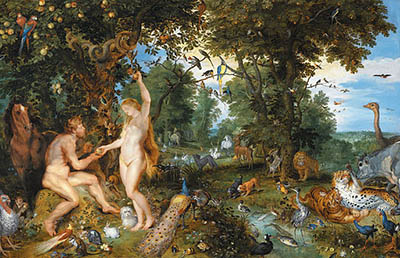
What purpose did creation stories in Genesis serve? Were they Biblical myths? Pictured here is The Garden of Eden with the Fall of Man (c. 1617) by Flemish painters Peter Paul Rubens and Jan Brueghel the Elder.
Were the creation stories in Genesis meant to be taken literally?
Maybe not, says biblical scholar Shawna Dolansky in her Biblical Views column “The Multiple Truths of Myths” in the January/February 2016 issue of Biblical Archaeology Review.
Our world is very different from the world in which the Biblical authors lived over 2,000 years ago. The ancient world did not have Google, Wikipedia and smartphones—access to information on human history and scientific achievements developed over millennia at the touch of their fingertips.
Many scholars believe that the ancient Israelites had creation stories that were told and retold; these stories eventually reached the Biblical authors, who wrote them down in Genesis and other books of the Bible. Creation stories in Genesis were etiological, Shawna Dolansky and other Biblical scholars argue.1 That is, the creation stories in Genesis served to provide answers to why the world was the way it was, such as why people wear clothes and why women experience pain during childbirth.

Creation stories in Genesis were among the many myths that were told in the ancient Near East. Today we may think of myths as beliefs that are not true, but as a literary genre, myths “are stories that convey and reinforce aspects of a culture’s worldview: many truths,” writes Dolansky. So to call something a myth—in this sense—does not necessarily imply that it is not true.
Scholars argue that Biblical myths arose within the context of other ancient Near Eastern myths that sought to explain the creation of the world. Alongside Biblical myths were Mesopotamian myths in which, depending on the account, the creator was Enlil, Mami or Marduk. In ancient Egyptian mythology, the creator of the world was Atum in one creation story and Ptah in another.
“Like other ancient peoples, the Israelites told multiple creation stories,” writes Shawna Dolansky in her Biblical Views column. “The Bible gives us three (and who knows how many others were recounted but not preserved?). Genesis 1 differs from Genesis 2–3, and both diverge from a third version alluded to elsewhere in the Bible, a myth of the primordial battle between God and the forces of chaos known as Leviathan (e.g., Psalm 74), Rahab (Psalm 89) or the dragon (Isaiah 27; 51). This battle that preceded creation has the Mesopotamian Enuma Elish as its closest analogue. In Enuma Elish, the god Marduk defeats the chaotic waters in the form of the dragon Tiamat and recycles https://masterra.com/order-essay.html her corpse to create the earth.”
In what other ways do Biblical myths parallel ancient Near Eastern myths? What can we learn about the world in which the ancient Israelites lived through the creation stories in Genesis? Learn more by reading the full Biblical Views column “The Multiple Truths of Myths” by Shawna Dolansky in the January/February 2016 issue of BAR.
Notes:
1. For example, see Ziony Zevit, “Was Eve Made from Adam’s Rib—or His Baculum?” BAR, September/October 2015; Mary Joan Winn Leith, “ReViews: Restoring Nudity,” BAR, May/June 2014.
Related reading in Bible History Daily:
The Adam and Eve Story: Eve Came From Where?
The Creation of Woman in the Bible
What Does the Bible Say About Infertility?
How the Serpent in the Garden Became Satan
Love Your Neighbor: Only Israelites or Everyone?
The Animals Went in Two by Two, According to Babylonian Ark Tablet
This Bible History Daily feature was originally published on January 31, 2016.
Get more biblical Archaeology: Become a Member
The world of the Bible is knowable. We can learn about the society where the ancient Israelites, and later Jesus and the Apostles, lived through the modern discoveries that provide us clues.
Biblical Archaeology Review is the guide on that fascinating journey. Here is your ticket to join us as we discover more and more about the biblical world and its people.
Each issue of Biblical Archaeology Review features lavishly illustrated and easy-to-understand articles such as:
• Fascinating finds from the Hebrew Bible and New Testament periods
• The latest scholarship by the world's greatest archaeologists and distinguished scholars
• Stunning color photographs, informative maps, and diagrams
• BAR's unique departments
• Reviews of the latest books on biblical archaeology
The BAS Digital Library includes:
• 45+ years of Biblical Archaeology Review
• 20+ years of Bible Review online, providing critical interpretations of biblical texts
• 8 years of Archaeology Odyssey online, exploring the ancient roots of the Western world in a scholarly and entertaining way,
• The New Encyclopedia of Archaeological Excavations in the Holy Land
• Video lectures from world-renowned experts.
• Access to 50+ curated Special Collections,
• Four highly acclaimed books, published in conjunction with the Smithsonian Institution: Aspects of Monotheism, Feminist Approaches to the Bible, The Rise of Ancient Israel and The Search for Jesus.
The All-Access membership pass is the way to get to know the Bible through biblical archaeology.
The post Should We Take Creation Stories in Genesis Literally? appeared first on Biblical Archaeology Society.


0 Commentaires